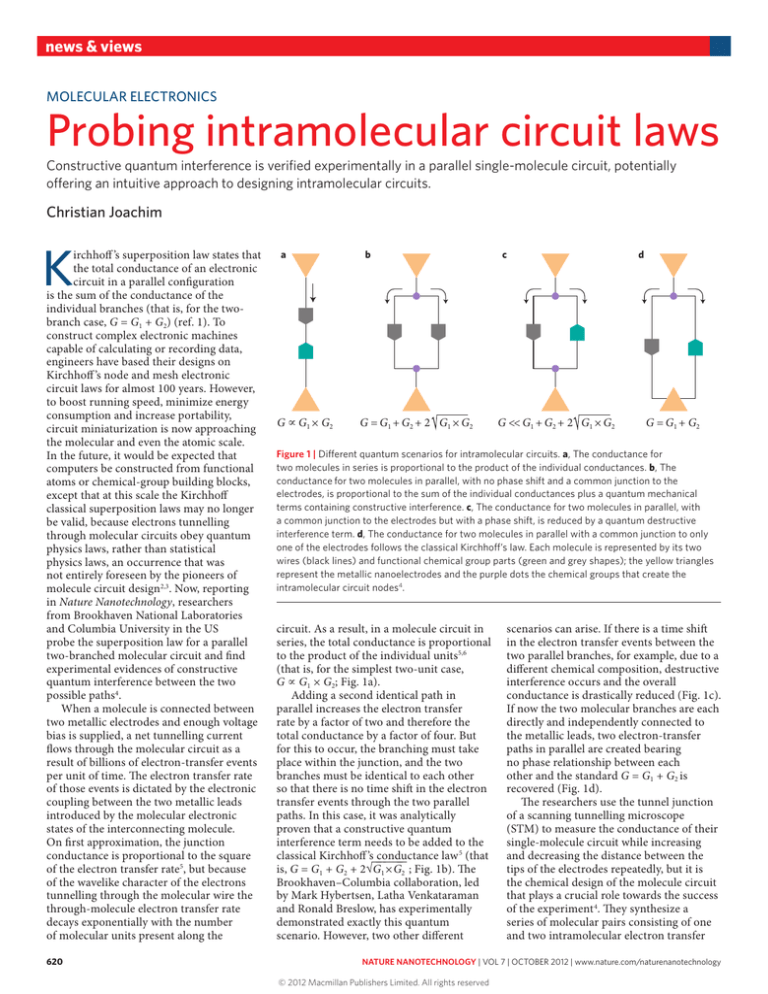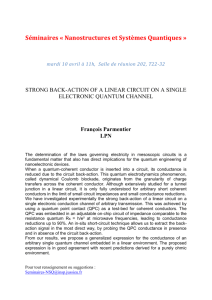
news & views
MOLECULAR ELECTRONICS
Probing intramolecular circuit laws
Constructive quantum interference is verified experimentally in a parallel single-molecule circuit, potentially
offering an intuitive approach to designing intramolecular circuits.
Christian Joachim
K
irchhoff ’s superposition law states that
the total conductance of an electronic
circuit in a parallel configuration
is the sum of the conductance of the
individual branches (that is, for the twobranch case, G = G1 + G2) (ref. 1). To
construct complex electronic machines
capable of calculating or recording data,
engineers have based their designs on
Kirchhoff ’s node and mesh electronic
circuit laws for almost 100 years. However,
to boost running speed, minimize energy
consumption and increase portability,
circuit miniaturization is now approaching
the molecular and even the atomic scale.
In the future, it would be expected that
computers be constructed from functional
atoms or chemical-group building blocks,
except that at this scale the Kirchhoff
classical superposition laws may no longer
be valid, because electrons tunnelling
through molecular circuits obey quantum
physics laws, rather than statistical
physics laws, an occurrence that was
not entirely foreseen by the pioneers of
molecule circuit design2,3. Now, reporting
in Nature Nanotechnology, researchers
from Brookhaven National Laboratories
and Columbia University in the US
probe the superposition law for a parallel
two-branched molecular circuit and find
experimental evidences of constructive
quantum interference between the two
possible paths4.
When a molecule is connected between
two metallic electrodes and enough voltage
bias is supplied, a net tunnelling current
flows through the molecular circuit as a
result of billions of electron-transfer events
per unit of time. The electron transfer rate
of those events is dictated by the electronic
coupling between the two metallic leads
introduced by the molecular electronic
states of the interconnecting molecule.
On first approximation, the junction
conductance is proportional to the square
of the electron transfer rate5, but because
of the wavelike character of the electrons
tunnelling through the molecular wire the
through-molecule electron transfer rate
decays exponentially with the number
of molecular units present along the
620
a
G ∝ G1 × G2
b
G = G1 + G2 + 2 G1 × G2
c
G << G1 + G2 + 2 G1 × G2
d
G = G1 + G2
Figure 1 | Different quantum scenarios for intramolecular circuits. a, The conductance for
two molecules in series is proportional to the product of the individual conductances. b, The
conductance for two molecules in parallel, with no phase shift and a common junction to the
electrodes, is proportional to the sum of the individual conductances plus a quantum mechanical
terms containing constructive interference. c, The conductance for two molecules in parallel, with
a common junction to the electrodes but with a phase shift, is reduced by a quantum destructive
interference term. d, The conductance for two molecules in parallel with a common junction to only
one of the electrodes follows the classical Kirchhoff’s law. Each molecule is represented by its two
wires (black lines) and functional chemical group parts (green and grey shapes); the yellow triangles
represent the metallic nanoelectrodes and the purple dots the chemical groups that create the
intramolecular circuit nodes4.
circuit. As a result, in a molecule circuit in
series, the total conductance is proportional
to the product of the individual units5,6
(that is, for the simplest two-unit case,
G ∝ G1 × G2; Fig. 1a).
Adding a second identical path in
parallel increases the electron transfer
rate by a factor of two and therefore the
total conductance by a factor of four. But
for this to occur, the branching must take
place within the junction, and the two
branches must be identical to each other
so that there is no time shift in the electron
transfer events through the two parallel
paths. In this case, it was analytically
proven that a constructive quantum
interference term needs to be added to the
classical Kirchhoff ’s—
conductance
law 5 (that
—
——
—
is, G = G1 + G2 + 2√G1 × G
2 ; Fig. 1b). The
Brookhaven–Columbia collaboration, led
by Mark Hybertsen, Latha Venkataraman
and Ronald Breslow, has experimentally
demonstrated exactly this quantum
scenario. However, two other different
scenarios can arise. If there is a time shift
in the electron transfer events between the
two parallel branches, for example, due to a
different chemical composition, destructive
interference occurs and the overall
conductance is drastically reduced (Fig. 1c).
If now the two molecular branches are each
directly and independently connected to
the metallic leads, two electron-transfer
paths in parallel are created bearing
no phase relationship between each
other and the standard G = G1 + G2 is
recovered (Fig. 1d).
The researchers use the tunnel junction
of a scanning tunnelling microscope
(STM) to measure the conductance of their
single-molecule circuit while increasing
and decreasing the distance between the
tips of the electrodes repeatedly, but it is
the chemical design of the molecule circuit
that plays a crucial role towards the success
of the experiment 4. They synthesize a
series of molecular pairs consisting of one
and two intramolecular electron transfer
NATURE NANOTECHNOLOGY | VOL 7 | OCTOBER 2012 | www.nature.com/naturenanotechnology
© 2012 Macmillan Publishers Limited. All rights reserved
news & views
paths with a common linker at each
end that does not electronically interact
with the metallic electrode of the STM
junction; rather, the linkers — or nodes,
in standard circuit terminology — are
part of the molecule itself, contributing to
its molecular electronic states. Moreover,
the linkers for the linear and branched
molecules are chemically similar and
electronically equivalent, allowing for
a direct comparison between the two
measured conductances.
But is it really necessary to synthesize
a molecule in the shape of a circuit to
miniaturize an electronic calculator to
the limit? Quantum physics offers at
least two more alternatives — each with
its own superposition laws — to take
advantage of intramolecular quantum
resources that unlike the Brookhaven–
Columbia system, which works in the real
domain, can operate in a dual space (real
and imaginary). One way is to structure
the molecule as an array of qubits and
have a well chosen initial quantum state
carrying enough information to encode
for a desired calculation to be computed
by quantum evolution of the system7. This
requires no intervention of intramolecular
electron transfer. Alternatively, and without
structuring the molecule in qubits, the
computational information is encoded
in the Hamiltonian as the system evolves
quantum mechanically in time starting
always from the same initial quantum
state, which in this case would carry no
quantum information8.
Thanks to the work by Hybertsen,
Venkataraman, Breslow and co-workers,
all three possible designs of intramolecular
calculating systems can now be tested
experimentally. The two dual-space
quantum approaches described above
have the advantage that an increase in
circuit complexity does not lead to a
large increase of the spatial extension of
the corresponding molecule, whereas
adding new chemical groups, however
synthetically demanding it may be, is so
intuitive an approach that it could have
a more practical and broader appeal for
circuit engineering, especially now that
the parallel superposition law has been
confirmed. It remains to certify, however,
which of these approaches will lead to
the maximum computing power per
single molecule.
❐
Christian Joachim is in the GNS-PicoLab and
MANA Satellite, CEMES-CNRS, 29, Rue J. Marvig,
BP 94347 31055 Toulouse Cedex, France.
e-mail: joachim@cemes.fr
References
1. Kirchhoff, G. Annalen der Physik und Chemie
4, Band LXIV (1845).
2. Carter, F. L. Physica D 10, 175–194 (1984).
3. Aviram, A. J. Am. Chem. Soc. 110, 5687–5692 (1988).
4. Vazquez, H. et al. 7, 663–667 (2012).
5. Magoga, M. & Joachim, C. Phys. Rev. B 59, 16011–16021 (1999).
6. Launay, J-P. Chem. Soc. Rev. 30, 386–397 (2001).
7. Nielsen, M. A. & Chuang, I. L. Quantum Computation and
Quantum Information (Cambridge Univ. Press, 2000).
8. Soe, W. H. et al. ACS Nano 5, 1436–1440 (2011).
QUANTUM DOTS
Strain is a problem no more
An elegant modification of nuclear magnetic resonance allows detailed structural analysis of self-assembled
semiconductor quantum dots, so far hindered by the intrinsic strain in these nanostructures.
Daniel Gammon
M
agnetic resonance of nuclear spin
is a beautiful example of quantum
control and measurement. It is
conceptually a simple process: first, the
application of a strong magnetic field causes
the spin to precess around the magnetic
field direction. Then a small periodically
alternating magnetic field is applied in the
direction perpendicular to that of the strong
one. When the frequency of the oscillations
is in resonance with the spin precession, the
nuclear spin can be flipped. Because the spin
precession depends on the type of nucleus,
nuclear magnetic resonance (NMR) can be
used to obtain structural information about
materials and has been extremely useful
in science and technology since it was first
demonstrated in the 1930s.
One of the challenges of NMR is that it
requires the presence of a great number of
nuclear spins, mostly because a single spin
normally has a very small net polarization,
even at cryogenic temperatures. A powerful
way to improve sensitivity is to use optical
pumping (Fig. 1). This consists of using light
to induce a polarization of the electron spins
that is then transferred to the nuclei through
the hyperfine interaction. Finally, any
modulation of the nuclear spin is transferred
back to the electron spin and can be detected
with sensitive optical methods. This optically
detected NMR (or simply ODNMR) can
be used to measure the response of the
nuclear spins even in a single semiconductor
quantum dot (QD) that contains typically
only 105 nuclei1.
The first ODNMR measurements of a
single QD were made more than a decade
ago on a GaAs QD (ref. 2), but there has
been relatively little progress since then.
This is because most QD research — in fact,
most of nanostructures research in general
— is on intrinsically strained materials, and
strain reduces the sensitivity of ODNMR
to an extent that obtaining structural
information is practically impossible.
Now, writing in Nature Nanotechnology,
Chekhovich and co-workers report an
elegant modification of ODNMR that not
only allows the structure of strained QDs
to be studied, but also gives information on
strain itself 3.
NATURE NANOTECHNOLOGY | VOL 7 | OCTOBER 2012 | www.nature.com/naturenanotechnology
© 2012 Macmillan Publishers Limited. All rights reserved
Strain leads to quadrupole splittings of
the nuclear spin spectrum. For example,
a nuclear spin with a total spin of 3/2 is
split in a magnetic field through the
Zeeman interaction. Strain combined with
quadrupole interactions adds additional
energy shifts. As a result, the four spin states
(−3/2, −1/2, 1/2 and 3/2) are split in energy,
and the NMR transition spectrum is split
into three resonance lines — not one as in
the case of an unstrained QD. The strain
is also inhomogeneous across the QD,
and each line broadens. Knowledge of the
spin splitting and of the inhomogeneity is
important for understanding the physical
properties of the QD. In the standard
ODNMR experiment, when one of the
resonances is matched by the frequency
of the alternating magnetic field, the spins
affected are only those of two adjacent
levels, and their populations vary until
they are equal. Unfortunately in this case,
the populations of the other levels are
not affected, and the signal is too low to
be detected. The situation is particularly
dramatic for atoms with higher nuclear spin,
621








